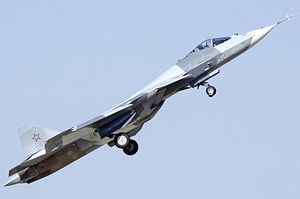The Russian military aircraft industry is ready to start manufacturing the Sukhoi Su-57 fighter aircraft, Russia’s first alleged indigenously designed and built fifth-generation stealth fighter jet, according to Russian Deputy Defense Minister Alexey Krivoruchko.
During a visit to the United Aircraft Corporation (UAC) Komsomolk-on-Amur aircraft plant in the Russian Far East the deputy defense minister said that the facility is ready to begin manufacturing the fighter aircraft. He also noted that the first Su-57 will be delivered to the Russian Air Force by the end of 2019.
“We will get the first fighter jet [of this model] by the end of this year,” Krivoruchko was quoted as saying by TASS news agency on May 29. “We are already talking about mass production. We have assessed the jet’s readiness today, as well as the plant’s readiness to mass manufacture of Su-57. We were fully satisfied with what we saw and hope that all plans will be fulfilled.”
The Russian Air Force was expected to receive two Su-57s prototypes by the end of 2019 and two more aircraft in 2020. However, these aircraft will not be in serial configuration. Mass production is not expected to begin before 2020. There are currently 10 Su-57 prototypes undergoing various stages testing and evaluation with the Russian Air Force.
Notably, the Russian Ministry of Defense announced in 2018 that it will not mass-produce the Su-57. In May, Russian President Vladimir Putin, however, announced that the Russian Air Force will procure a total of 76 Su-57s by 2028, although no contract to that effect has yet been concluded with UAC. Last month, Russian Minister of Defense Sergei Shoigu also reported that the per-unit cost per Su-57 and associated equipment went down by 20 percent.
As I wrote elsewhere, next to questions surrounding the financial viability of the Su-57, the program has also been delayed due to various design and technical challenges, primarily surrounding with the aircraft’s next-generation engine:
The Saturn izdeliye 30 will not be ready for serial production until at least 2020.
The new engine features increased thrust and fuel efficiency and is reportedly fitted with 3D thrust vectoring nozzles. All of the 10 Su-57 prototypes have been fitted with a derivative of the Russian-made Saturn AL-41F1S engine, the AL-41F1, an older aircraft engine also installed on the Sukhoi Su-35S Flanker-E.
The new engine also enables the Su-57 to supercruise without afterburners. Additionally, I pointed out:
The Su-57 lacks high-end low-observable design features and the aircraft’s sensor suite and other mission systems continue to suffer from developmental issues. The aircraft also reportedly cannot carry some of Russia’s most advanced air-launched weapons systems, including the BrahMos-A and KH-35UE, in its internal weapons bay, turning the missiles into radar cross section hotspots.
Consequently, it would be a mistake to expect the Su-57 to compete with Western-made fifth-generation aircraft such as Lockheed Martin’s F-22 Raptor of the F-35 Lightning II Joint Strike Fighter in terms of stealth capabilities. However, one should note that this was also never the intention of the Russian aircraft designers.
According to Russian state arms exporter Rosoboronexport, the Su-57 will be shown at the MAKS airshow, held at the Zhukovky International Airport, southeast of Moscow in late August. Russia has been offering the Su-57 to both India and China.































